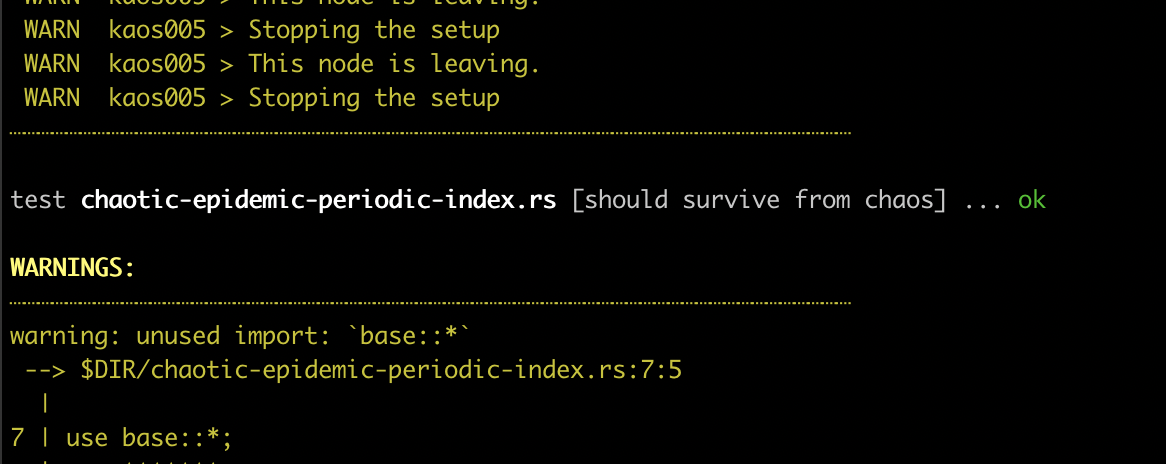//! #### Chaotic testing harness
//!
//! **Kaos** is a chaotic testing harness to test your services against random failures.
//! It allows you to add points to your code to crash sporadically and
//! harness asserts availability and fault tolerance of your services by seeking
//! minimum time between failures, fail points, and randomized runs.
//!
//! Kaos is equivalent of Chaos Monkey for the Rust ecosystem. But it is more smart to find the closest MTBF based on previous runs.
//! This is dependable system practice. For more information please visit [Chaos engineering](https://en.wikipedia.org/wiki/Chaos_engineering).
//!
//! # Test Setup
//!
//! It is better to separate resilience tests.
//! Create a directory that will hold all chaos tests. In our example it will be `kaos-tests`.
//!
//! A minimal launcher for kaos setup looks like this:
//!
//! ```
//! #[test]
//! fn chaos_tests() {
//! let k = kaos::Runs::new();
//!
//! for entry in fs::read_dir("kaos-tests").unwrap() {
//! let entry = entry.unwrap();
//! let path = entry.path();
//!
//! // Every service run should be available at least 2 seconds
//! k.available(path, Duration::from_secs(2));
//! }
//! }
//! ```
//!
//! and in your Cargo.toml
//!
//! ```toml
//! [[test]]
//! name = "chaos_tests"
//! path = "kaos-tests/launcher.rs"
//! ```
//!
//! Mind that there two types of tests, first one is: availability test, the latter one is chaotic test which seeks the minimum timing, failure, MTBF combination.
//! The setup shows availability tests as an example. When availability tests run you will see:
//!
//!
//!  //!
//!
//!
//!
//! ## Definining flunks
//! In kaos there is a concept of [flunk]. Every flunk is a point of failure with panic. This can be redefinable.
//! After adding kaos as dependency you can add flunk points to define fallible operations or crucial points that system should continue its operation.
//!
//! Basic flunk is like:
//! ```rust
//! use kaos::flunk;
//! fn vec_check(v: &Vec) {
//! if v.len() == 3 {
//! flunk!("fail-when-three-elems");
//! }
//! }
//! ```
//! This flunk point will be used later by kaos.
//!
//! ## Writing tests
//! Test harness will execute tests marked by a launcher. An example test for the flunk mentioned above is like this:
//! ```
//! # use std::panic;
//! # use kaos::flunk;
//! # fn vec_check(v: &Vec) {
//! # if v.len() == 3 {
//! # flunk!("fail-when-three-elems");
//! # }
//! # }
//! use kaos::kaostest;
//!
//! kaostest!("fail-when-three-elems",
//! {
//! panic::catch_unwind(|| {
//! let mut v = &mut vec![];
//! loop {
//! v.push(1);
//! vec_check(v);
//! }
//! });
//! }
//! );
//! ```
//! # Chaos Tests
//!
//! In addition to availability tests mentioned above we can test the software with chaos tests too.
//! For using chaotic measures and finding bare minimum failure, timing and MTBF combination
//! you can configure chaos tests in your launcher:
//!
//! ```
//! #[test]
//! fn chaos_tests() {
//! let k = kaos::Runs::new();
//!
//! for entry in fs::read_dir("kaos-tests").unwrap() {
//! let entry = entry.unwrap();
//! let path = entry.path();
//!
//! // Let's have 10 varying runs.
//! let run_count = 10;
//!
//! // Minimum availability to expect as milliseconds for the runs.
//! // Which corresponds as maximum surge between service runs.
//! // Let's have it 10 seconds.
//! let max_surge = 10 * 1000;
//!
//! // Run chaotic test.
//! k.chaotic(path, run_count, max_surge);
//! }
//! }
//! ```
//! This launcher produce multiple results like:
//!
//!
//!  //!
//!
//!
//! Now you know all the basics, what you have to do is *unleash some chaos* with `cargo test`.
//!
//! Kaos is using the same approach that [trybuild](https://docs.rs/trybuild) has.
//! Instead of being compiler-like test harness, it has diverged to be chaos engineering
//! oriented harness.
#![doc(
html_logo_url = "https://raw.githubusercontent.com/vertexclique/kaos/master/img/chaos.png"
)]
extern crate humantime;
#[macro_use]
mod term;
#[macro_use]
mod path;
mod cargo;
mod dependencies;
mod diff;
mod env;
mod error;
mod features;
mod manifest;
mod message;
mod normalize;
mod run;
mod rustflags;
mod macros;
use std::cell::RefCell;
use std::path::{Path, PathBuf};
use std::{time::Duration, thread};
#[doc(hidden)]
pub use fail::eval as flunker;
#[doc(hidden)]
pub use fail::cfg as flunker_cfg;
#[doc(hidden)]
pub use fail::FailScenario as KaosFailScenario;
pub use macros::*;
///
/// Chaotic runs test setup
#[derive(Debug)]
pub struct Runs {
runner: RefCell,
}
#[derive(Debug)]
struct Runner {
tests: Vec,
}
#[derive(Clone, Debug)]
struct Test {
path: PathBuf,
duration: Option,
max_surge: isize,
expected: Expected,
}
#[derive(Copy, Clone, Debug)]
enum Expected {
Available,
Chaotic
}
impl Runs {
#[allow(clippy::new_without_default)]
pub fn new() -> Self {
Runs {
runner: RefCell::new(Runner { tests: Vec::new() }),
}
}
pub fn available>(&self, path: P, duration: Duration) {
self.runner.borrow_mut().tests.push(Test {
path: path.as_ref().to_owned(),
duration: Some(duration),
max_surge: !0,
expected: Expected::Available,
});
}
pub fn chaotic>(&self, path: P, run_count: usize, max_surge: usize) {
(0..run_count).into_iter().for_each(|_| {
self.runner.borrow_mut().tests.push(Test {
path: path.as_ref().to_owned(),
duration: None,
max_surge: max_surge as isize,
expected: Expected::Chaotic,
});
});
}
}
#[doc(hidden)]
impl Drop for Runs {
fn drop(&mut self) {
if !thread::panicking() {
self.runner.borrow_mut().run();
}
}
}
 //!
//!  //!
//!  //!
//!